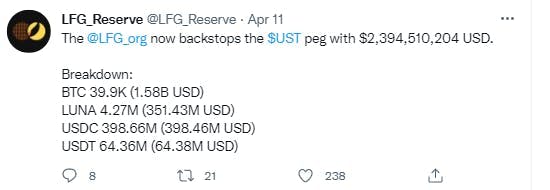The Rise and Fall of UST: An Analysis of the Algorithmic Stable Coin's Recent Market Turmoil
Terra USD (UST), recently rebranded to TerraClassicUSD (USTC), an algorithmic stable coin that is supposed to be pegged 1:1 with the US Dollar, seems to be the victim of an attack similar to how the bank of England had fallen victim in 1992 in a move by George Soros. With a price of only $0.42 per token, it is currently in a tough battle facing a significant risk of permanently losing all its value. How did UST lose over $50 billion, and what does it mean for the crypto ecosystem? Let's dig in to find out!
TerraClassicUSD on CMCByRick van Melis — Explainers
4 min read

Introduction
UST is an algorithmic stable coin that uses a secondary token called LUNA to maintain its value. When the price of UST falls below $1, new LUNA is minted and sold at a discount to buy and burn UST from the open market. Conversely, when the price of UST is above $1, traders are incentivized to burn Luna in exchange for UST, increasing the supply and theoretically causing the price to eventually drop back to $1. The goal of this system is to stabilize the market through arbitrage and incentivization. However, this system can be vulnerable to market movements and does not have a reserve of fiat currency as collateral, like other stable coins such as USDC and USDT.
Deep Dive
Recently, concerns have been raised about the sustainability of interest rates in one of Terra's main utilities, the anchor Protocol, which is similar to a savings account. This may have contributed to some anxiety among its users. In March 2022, the Luna Foundation Guard (LFG) began purchasing Bitcoin (BTC) as collateral in case of emergencies. By March 26th, the LFG had amassed over $1 billion worth of BTC, which set the stage for the subsequent attack.

Recently, concerns have been raised about the sustainability of interest rates in one of Terra's main utilities, the anchor Protocol, which is similar to a savings account. This may have contributed to some anxiety among its users. In March 2022, the Luna Foundation Guard (LFG) began purchasing Bitcoin (BTC) as collateral in case of emergencies. By March 26th, the LFG had amassed over $1 billion worth of BTC, which set the stage for the subsequent attack.
The second factor leading up to the attack was the announcement of the 4pool, a stable coin liquidity pool intended to strengthen the cross-chain peg for UST and other stable coins. The 4pool is set to replace the current 3pool. It is believed that the attacker borrowed 100,000 BTC from Gemini to secure sufficient liquidity to execute the attack, creating shorts and long future positions to make it profitable. In total, the attack likely had a $4.2 billion short position on BTC and $1 billion in UST.
On May 8th, the LFG removed $150 million from the 3pool liquidity. Almost immediately, the attacker used $350 million of UST to drain the remaining curve liquidity. This only caused the UST peg to drop to $0.972. In response, the LFG started selling BTC to defend the peg, which caused downward pressure on BTC while the attack on UST was still ongoing.
The attack then continued on the Binance exchange, where the remaining $1 billion of UST was sold. This triggered a panic among UST and anchor users, causing the peg to spiral down to as low as $0.70 as people rushed to sell. Meanwhile, the LFG was selling more BTC and buying UST, which may have contributed to Bitcoin dropping 25% from $42,000 to $31,300. The Terra chain became congested, and several central exchanges suspended withdrawals of UST, further exacerbating the panic. The peg hit its lowest point of $0.60 on May 10th.
Over the following days, there was a battle between the UST algorithm, the LFG, the attacker, and panicked UST users. Luna was continuously minted and its value dropped from an all-time high of $40 billion to $800 million. It is estimated that the attacker may have profited by at least $800 million.
Terra and LFG founder Do Kwon eventually tweeted out a plan to save the UST peg. The algorithm would be modified to allow for the faster minting and burning of Luna, with the goal of buying up and burning UST more quickly. It is not yet clear if this plan will be successful in stabilizing the UST peg. The community has also suggested other potential solutions, such as using BTC as collateral and issuing a hard fork. It remains to be seen how the situation will be resolved.
Conlusion
In conclusion, the recent market turmoil of the algorithmic stable coin UST highlights the potential vulnerabilities of using a secondary token like LUNA to maintain its value. While the system of incentivization and arbitrage aims to stabilize the market, it can be disrupted by external factors such as the accumulation of BTC by the Luna Foundation Guard and the announcement of the 4pool. The panic that ensued among UST and anchor users further exacerbated the situation, leading to a significant drop in the peg's value. While Terra and LFG founder Do Kwon has proposed a plan to save the peg by modifying the algorithm to allow for faster minting and burning of Luna, it is not yet clear if this will be effective. The community has also suggested other potential solutions, such as using BTC as collateral and issuing a hard fork. The resolution of this situation will have important implications for the future of UST and other algorithmic stable coins.